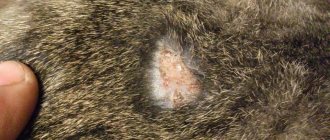Save the article:
It happens that a beloved pet receives a gift from nature of neighbors in the body - worms. Not the most pleasant neighborhood, from which the animal’s body will suffer for a long time if the owner does not undertake deworming. Worms in a cat are a serious disease that depresses all systems of the body: the animal loses weight, eats poorly, and becomes very tired.
Where does such a misfortune come from? Such unkind guests easily enter the body, but leave with reluctance. If you suspect unwanted neighbors, it is better to visit the veterinarian and find out who decided to destroy the cat from the inside.
How do you know that the treatment has worked?
Anthelmintics have different effects on parasites: some have a paralytic effect, causing neuromuscular blockade, others destroy metabolism, and others deprive them of the ability to reproduce. After taking anthelmintic tablets, the worms begin to leave the body. They can crawl out alive, or come out dead; often only fragments of worms are found in the excrement.
Detection of helminths in the feces for several days after taking the drug and their absence in the future, improvement in well-being indicate that the treatment was successful.
How to give a cat a deworming tablet
Giving a cat a pill is not an easy task. No matter how hard you try to persuade the animal to open its mouth and swallow the “delicacy,” there will be no result. There is a standard algorithm of actions that will help feed a cat a medicinal drug.
It is best to crush the tablet into powder and roll it into a ball with a tasty treat, sit the animal with its back to you and unclench its jaws. The medicinal ball is stuffed into the pet’s mouth and closed, stroking the pussy’s throat. As soon as the swallowing movement is made, you need to make sure that the medication is swallowed.
There are other ways to give your cat the pill.
Types of worms in cats
Few people have wondered what worms look like in cats. All varieties of helminths are worms that are predominantly white in color. Their sizes can be very tiny, or they can exceed 1.5-2 meters.
Worms look like this and have the following characteristics:
- Tapeworms;
- Roundworms;
- Flat flukes.
Each of these varieties is incredibly dangerous not only for the animal, but also for the creatures that live with it, including humans and their families.
1. Tapeworms are a type of parasite that lives primarily in the intestines of animals or humans. They are one of the most common types that appear in animals as a result of eating fish and meat. It can also be caused by lice or fleas. They provoke the development of diseases such as diphyllobothriasis, dipylidiasis, alveococcosis.
Symptoms of infection:
- Loss of appetite;
- Drowsiness;
- The wool loses its natural shine;
- Diarrhea or constipation;
- Anemia.
After infection, tapeworms do not manifest themselves in any way, so the disease is asymptomatic. This type of helminth is incredibly dangerous for humans, as it is fatal.
2. Roundworms are the most agile and tenacious parasites that penetrate the animal in utero. Thus, the cause of infection can be helminth eggs brought on clothing or after contact with the feces of sick animals. They provoke the development of hookworm disease and toxascariasis.
Symptoms of infection:
- Loss of appetite;
- Increased thirst;
- Lethargy, loss of strength;
- Diarrhea;
- Frequent vomiting.
If these parasites are not eliminated in a timely manner, then a kitten or adult cat may die from a ruptured intestine, which will literally be overflowing with parasites. Even if you have a normal appetite, you should always pay attention to the slightest changes in your pet’s behavior.
3. Flat flukes are a species that is quite rare in cats, but still pose a danger to them. Thus, flat flukes appear after eating infected shellfish or river fish. Causes the diseases paragonimiasis and opisthorchiasis.
Symptoms of infection:
- Persistent and severe cough;
- Loss of appetite;
- Decreased activity;
- Temperature increase;
- Vomiting with white foam;
- Diarrhea.
When infected with this type of helminth, a kitten or cat begins to behave very restlessly and aggressively. He develops unbearable pain in his stomach, due to which he will break out of your hands and avoid any contact with you. So, if the disease is ignored, the animal may die.
Infection and progression occurs quite quickly. Often, worm eggs can be found on the fur of an animal located near the anus.
Infection
It would be a mistake to think that if a kitten does not go outside for walks, then it actually cannot become infected with such infections. Let's look at why this happens :
- you can bring parasites from the street along with shoes or other foreign objects;
- worm eggs can settle in flower pots, which is especially dangerous for those who like to travel around the apartment, exploring new territories;
- Raw, unprocessed foods, especially meat and river fish, can be a threat to your kitten's health and cause serious symptoms of illness;
- if there are other animals in the house, it is worth treating all of them at the same time, otherwise one of them may still have parasites, which are then transmitted again to others;
- failure to maintain constant hygiene and disinfection of the animal’s tray and food bowls, as well as all places where she likes to go most often;
- if a pregnant cat was a carrier of helminths, they could be transmitted to babies without obvious symptoms and signs, which is especially dangerous;
- Fleas and other small parasitic insects that can be observed in animals are also carriers of the infection.
However, unfortunately, even constant monitoring and maintenance of the healthy and proper functioning of a pet cannot guarantee 100% protection against infection. Therefore, in any case, you should not wait for extreme cases and serious symptoms when there is nowhere to put it off, and carry out regular deworming of your pet in any way more convenient for you.
Where do worms live in a cat's body?
Signs of the disease when parasitized by one or another type of worm in cats are largely determined by the location of the infestation. And there are quite a lot of these places in the body. Worms in a cat. Worms can settle and subsequently destroy the balance of a living system in almost any organ. They can be found in: intestines; stomach; liver; lungs; kidneys; bladder; and even in the heart or eyes.
Mostly felines are affected by: intestinal parasites – roundworms (ascariasis, toxacorosis); liver - flukes (opisthorchiasis).
In rare cases, helminths can be found in organs and tissues of the host that are unusual for their biology, then they speak of “perverted localization.” With this form of the disease, the parasitic worm for the most part cannot complete the full course of development, but the body still experiences some signs of discomfort.
In addition, there is a so-called transit localization, when larvae or eggs pass through the cat’s body without stopping anywhere and without having any negative impact on health.
The danger of helminthiasis
The initial stage of the disease does not harm the animal - except that it loses a little weight. But parasitosis does not go away on its own, and if treatment is not started, everything will progress to an advanced stage, which can lead to complications.
For the animal
Worms in cats can cause irreparable harm to the body and even cause death. What disorders occur in the body of an infected pet:
- worms gnaw passages in internal organs, causing damage and hidden bleeding;
- waste products of parasites poison the animal, it begins to vomit, diarrhea, and refuses to eat;
- the pet’s immunity drops and it becomes vulnerable to infections and viruses;
- severe infection is fraught with blockage and obstruction of the intestines, and if the localization of the worms is in the heart or blood vessels, then there is a high probability of damage to vital arteries.
The latter options are extremely dangerous, as they can be fatal. Advanced cases should be treated only under the supervision of a veterinarian.
For man
A person runs the risk of becoming infected from the animal with whom he lives. It is enough to pet your pet and not wash your hands for the probability of transmitting the parasite to be 90%. Therefore, when worms are detected in cats, not only four-legged friends, but also all family members, especially children, undergo deworming.
Prevention measures
It is much easier to prevent the body from becoming infected with intestinal parasites than to think later than to remove them without harm to health. Prevention of worms in cats comes down mainly to hygienic and sanitary rules and regulations:
- clean the hallway and wash it more often;
- store all shoes in a separate locked cabinet and wash them regularly;
- exclude contact with other animals, especially wild animals, including rodents and birds;
- treat your pet for fleas, since infestation in cats often occurs precisely because of these parasite spreaders.
Folk remedies can help eliminate heartworms in cats and other infestation problems, because they can be used not only for treatment. So, if a cat does not eat dry food, it is not so difficult for him to add a little fresh garlic to his food.
In cats, parasites can be eliminated without expensive medications. But in any case, you need to think about how to poison worms immediately. Helminthiasis is the cause of more serious diseases, sometimes even deadly. And that is why a caring owner will immediately take all necessary measures to preserve the health of the pet.
Features of treating kittens for worms
Sometimes owners, when they notice the slightest suspicion of signs of the presence of worms, raise a terrible panic and even try to get rid of the pet as quickly as possible. However, do not rush to conclusions!
First of all, it is worth remembering that for a successful and peaceful stay of a kitten in your home, you should carry out regular treatment for worms in kittens.
This is due, first of all, to the fact that you may not notice the symptoms of the appearance of parasites, which will subsequently lead to irreparable harm to the health and life of your pet, as well as the possibility of infecting your loved ones, especially small children. Therefore, preventing worms in kittens is a prerequisite for ensuring a full life and impeccable health for your cat!
© shutterstock
Still don't know how to identify worms in your pet? The best solution would be to seek help and qualified advice from a veterinarian. He will conduct all the necessary studies, ask you to take tests, after which he will be able to make a complete and 100% accurate diagnosis and describe further treatment for worms using anthelmintic drugs.
Manifestations of invasion
How can you tell if your furry pet has worms? Here are the common signs of worms in cats:
- manifestation of poor appetite;
- a sharp decrease in body weight;
- signs of worms can be determined in cats by the condition of their fur - it becomes disheveled, loses its smoothness and shine;
- the problem can be determined by observing the cat's stool (if diarrhea alternates with constipation, this should alert the owner);
- the stomach becomes bloated;
- vomiting begins;
- should be recognized by purulent discharge from the eyes;
- You can also understand by the appearance of an unpleasant odor from the mouth;
- behavior becomes restless and irritable.
Symptoms of worms in cats may depend on the area in which the microorganisms are parasitizing, or on their type. Three types of worms can live in a cat's body - tapeworms (cestodes), roundworms (nematodes) and flukes (trematodes).
How can you tell if your cat has worms related to tapeworms? Several types of worms can be causative agents of cestodosis:
- The tapeworm contributes to the development of a disease such as Diphyllobothriasis. What do worms look like in cats of this species? Their length reaches 1.5 meters, they live in the straight or thick part of the intestine, destroying the mucous surface. A pet can become infected if it eats raw fish. In a cat, signs of the presence of worms will be manifested by loss of appetite, vomiting, and loss of body weight. The wool loses its shine and smoothness.
- Cucumber tapeworm causes the disease Dipylidia. Their length can reach 30 cm, they live in the intestines. A cat can become infected from fleas and ticks. In cats, signs of worms in this case manifest themselves in the form of loss of activity, the cat eats poorly, diarrhea and vomiting are observed.
- Alveococcus contributes to the development of Alveococcosis. It is practically impossible for a domestic cat to become infected with them. The source is eaten by rodents. These helminths in cats reach a length of up to several millimeters and settle in the small intestine. The disease may occur without any symptoms. Or cats develop symptoms similar to any other intoxication.
Nematodosis is caused by the following pathogens:
- The helminth Toxocara provokes the disease Toxacaridiasis. Parasites have an elongated shape with pointed ends and settle in internal organs, sometimes in the gall bladder and liver. How to understand the disease? Symptoms of the presence of worms manifest themselves in the form of vomiting streaked with blood, frequent loose stools, weight loss, and lack of appetite.
- The hookworm roundworm causes the disease Hookworm. The worm is very small, reaches only 2 mm, parasitizes in the intestines and feeds on blood. The worm enters the body through the mouth and skin. In cats, helminthic infestation will manifest itself as diarrhea, vomiting (sometimes even with blood), and frequent coughing.
Trematodes occur as a result of infection with flukes.
- The causative agent of Paragonimiasis is the pulmonary fluke. The larvae live in the lungs, destroying the cells of the pulmonary lining. Infection occurs through raw seafood. How can you tell if a cat of this type has worms? The cat constantly coughs, wheezes, body temperature rises, and vomiting occurs.
- Opisthorchiasis develops when the opisthorchiasis fluke enters the cat's body. These cat helminths live in the liver, less often in the pancreas or gall bladder. They penetrate inside along with raw fish. You can tell that a cat has worms by an increase in body temperature, refusal to eat, vomiting and diarrhea.
Types of cat helminths
All types of worms in cats are divided into three large groups: round, flat and tape. They differ from each other in their distribution methods and habitats. The specifics of symptoms and treatment of worms in a cat directly depend on the type of parasite.
Roundworms (nematodes)
The most common types of nematodes in cats are :
- Toxocara, or roundworm, is the most common species found in the cat's body. They grow from 3 to 10 cm in length and live exclusively in the small intestine. Their eggs leave the body along with feces, end up in the soil, water, and can sometimes be contained in dust. Often, a pet becomes infected with nematodes by eating raw meat. Once in the intestine, the eggs pass through its walls and penetrate into the blood, and then spread throughout the animal’s body. After some time, they reach the lungs, where they rapidly develop, causing discomfort to the animal and causing coughing. Along with sputum, some of the mature eggs enter the stomach, and then again into the intestines, where adult worms lay eggs again.
- Hookworms enter the body through the skin, reach a length of no more than 2 mm, multiply and parasitize in the intestines.
- Heartworms, or heartworms. They enter the body through the bites of infected mosquitoes or fleas. Penetrating into the blood, they reach the heart, muscles, lungs, or settle in blood vessels, where they multiply.
People can also become infected with nematodes if they do not wash their hands after contact with an infected animal or after cleaning its tray.
Tapeworms (cestodes)
Tapeworms live exclusively in the intestines. Using small sharp hooks located in the front of the body, the worms cling to the walls of the colon. Cestodes are found in low-quality raw meat. There are several cestodes that are potentially dangerous for cats and kittens:
- Cucumber tapeworm. This parasite grows in the animal's body from 10 to 70 centimeters. The body of the worm consists of a head, with which it clings to the intestinal wall, and segments that contain eggs. As soon as they mature, the segments break off and are passed out in the feces. The eggs enter the bodies of insects. If a cat eats an infected fly or a flea with parasites living in its body gets on its body, the pet will become infected.
- Wide tape. It is similar to the previous species, but its eggs develop mainly in river fish and crustaceans. In this case, after eating raw fish or swimming in a river, your pet can catch the infection.
- Echinococci and alveococci. Their temporary carriers are rabbits and rodents. They grow up to 4 mm in length. This type of worm is the most dangerous because while the adult representatives live in the intestines, their larvae spread throughout the body, settling in the brain, eyes, heart, liver and other organs.
Cestodes are not dangerous for people in contact with a pet. However, like animals, humans can become infected with worms through the meat of intermediate carriers (fish, beef, crustaceans, etc.).
Trematodes (flukes)
The rarest type of parasite found, but also the most dangerous. Flukes feed on animal tissues, destroying and damaging them. What types of these worms are found in cats:
- Cat fluke. Its scientific name is opisthorchus. This parasite grows from 5 to 150 millimeters and mainly affects the liver and gall bladder. They have a complex life cycle, which includes as many as two intermediate carriers. First these are snails, crustaceans and other small river creatures, then fish. Thermally untreated fish can cause infection in your pet.
- The pulmonary fluke spreads in a similar way, but its habitat is the lungs of the animal.
Due to their complex development cycle, trematodes are not dangerous to humans. Infection from both the pet and the carrier fish is excluded.
Symptoms and first signs of the appearance of worms in cats
Signs of worms in cats and kittens can differ significantly. This is due to the fact that in an adult and stronger animal, resistance to parasites may be higher, but this in no way excludes prevention and timely treatment in case of infection. Thus, the symptoms and signs exhibited by helminth disease directly depend on the degree of damage to the body by parasites.
At first, your pet may behave normally and not show any concern. The initial stage of infection does not manifest itself in any way, but develops at incredible speed, causing your pet to weaken every day. So, if your pet is free-range and often comes into contact with other animals, then prevention must be carried out regularly.
Don't be surprised if you keep your house squeaky clean and your pet picks up helminths. Worm eggs easily attach to the soles of shoes, clothes, and bags. If you do not wash your hands and pet your cat, then rest assured that he may soon become infected.
The main symptoms of infection in cats may be as follows:
- Lethargy and fatigue;
- Their presence in feces;
- Intestinal upset alternating with constipation;
- Sudden weight loss;
- Severe bloating and tight belly;
- Refusal to eat;
- Vomit;
- Loss of fur and its former healthy shine;
- "Riding" on the butt;
- Restlessness and nervousness.
It is worth remembering that the symptoms of worms in cats are quite similar to the signs of other, no less dangerous and serious diseases. So, there is no need to rush and give your pet anthelmintic drugs, which can cause complications of the disease and prevent an accurate diagnosis from being made at a veterinarian’s appointment.
Symptoms of the presence of worms should be confirmed by a stool test. This procedure gives the most accurate results and will help prescribe the necessary treatment for the animal, depending on the severity of the parasite damage.
How to determine the presence of helminths in a cat or kitten?
To understand that a cat has parasites, a detailed veterinary examination and mandatory deworming are necessary.
Deworming is a whole range of health and preventive measures that help rid the animal of invasive material that is harmful to the health and condition of internal organs. Deworming is the use of anthelmintics that destroy not only worms, but also all intestinal parasites.
Veterinary examination is carried out by taking tests and examining the animal by a doctor. Tests can determine the presence of eggs and dead helminths, but not always accurately and reliably. When magnified under a microscope, the feces may be clean and the animal remains undiagnosed. But this does not mean that infection did not occur. Different types of worms are diagnosed in different ways. Therefore, if the tests do not show results, other studies are prescribed.
Individual segments of the worms can be seen independently. They can be observed in the animal's stool, on the fur or around the anus. Outwardly, they resemble triangles or grains of rice. As soon as you discover unknown objects in your pet’s feces, you need to urgently take her to a veterinary hospital and not self-medicate, which can only aggravate the existing situation.
Symptoms of helminth infection
Despite the fact that each type of parasite is characterized by special symptoms, there are several common signs of worms in a cat:
- changes in the animal’s behavior – usually nervousness, lethargy, a desire to take cover and sleep longer;
- loss of appetite or complete refusal to eat - in case of infection with lungworms or heartworms;
- increased appetite due to intestinal parasites;
- hair loss, dullness, tuftiness;
- abdominal enlargement;
- problems with the digestive system: diarrhea, constipation and their alternation, rapid weight loss, causeless vomiting.
Owners of healthy animals with good immunity often do not notice the appearance of parasites due to the fact that there may be no symptoms at all. They appear only at an advanced stage.
If helminths have settled in the intestines or stomach, they can be identified by bloody impurities in the cat’s feces, bloating or diarrhea. Check your cat for the following symptoms: pale mucous membranes, itching and irritation in the area under the tail, vomiting and thirst.
Heart parasites are characterized by general exhaustion, vomiting and severe coughing, shortness of breath, and an increase in the animal’s body temperature. The cat does not play, eats little and breathes whistlingly.
If worms in cats have settled in the liver, the pet vomits yellow and is bothered by pain in the right side. The doctor may also detect liver enlargement and nodularity.
Due to parasites in the lungs, the cat will often cough and even spit out blood. In addition, chest wheezing and fever are distinctive symptoms.
Symptoms are more pronounced in older individuals or in animals with weakened immune systems. If worms are found in a kitten, it will not be surprising that he lags behind his brothers in mental and physical development. He develops other health problems if treatment is not prescribed on time. In extremely advanced cases, the baby may die.
General signs
Without going into details, without finding out the type of parasites and their number, we can only give the symptoms of infection. The contrast of the clinical picture depends on the location of the worms. As you know, worms can live in the intestines, liver, heart, lungs, and brain.
The most common parasites settle in the gastrointestinal tract, that is, in the small intestine, and then in the large intestine. Since parasites drink blood and gain access to nutrients directly, the animal's condition noticeably worsens. With severe infestation, especially in kittens, the abdomen noticeably swells (the body shape becomes pear-shaped). Apathy and weakness are observed in the behavior of the animal; from a physiological point of view, the following can be observed:
- Alternating diarrhea and constipation.
- The presence of parasites in the blood or body fragments in the stool.
- Vomit.
- White, thick discharge from the eyes.
- Loss of a healthy appearance of the coat - lack of shine, tufts of fur that do not adhere to the body.
- Loss of fur pigmentation, as if the cat has turned grey.
- Hair loss or increased fragility.
- Fetid odor from mouth.
- Itching in the anal area - the cat constantly licks or bites the itchy area.
- Loss of appetite or worsening of it.
- Weight loss regardless of appetite and amount of food consumed.
- Anemia is a low level of hemoglobin in the blood.
- Blueness or pallor of mucous membranes.
- Unreasonable chills.
- Tremors or convulsions with severe intoxication.
Intestinal infestation can manifest itself in a variety of ways, and symptoms depend on the number of parasites and the overall health of the animal. Without any doubt, the presence of worms affects the level of the body's immune defense, that is, an infected cat is more prone to colds and viral diseases. During an external examination, the symptoms may be vague, which is why the diagnosis is made on the basis of a scraping from the anus or a laboratory examination of stool.
Parasites can live not only in the intestines. There is a type of worm, the larvae of which migrate through the bloodstream and settle in the eyes of the animal. When the worms grow, the cat sees them as shadows or spots, which is expressed in its behavior. Lungworms cause regular bronchitis and cough. With severe infestation, the worms gnaw through the walls of the lungs, which leads to fluid effusion and pneumonia.
The cat vomited worms: 5 reasons
The infestation of animals by parasites is the rule rather than the exception. Pets that do not walk outside are also not immune from helminthiases. Worm eggs and larvae are everywhere: in the ground, crowded places, tap water, food.
Upon contact with outer clothing, shoes, or water, roundworms and nematodes enter the body.
Vomiting of worms is a consequence of a number of reasons:
- Severe worminess. In the absence of anthelmintic prophylaxis, helminths multiply quickly, and the body rejects the excess.
- Intestinal obstruction. An excessive number of worms creates congestion in the digestive organ, disrupting peristalsis.
- Intoxication. Nematodes and Giardia produce toxins. Vomiting is a protective reflex during poisoning; some parasites are released in the vomit.
- Damage to internal organs. Worms cause inflammatory processes in the stomach, liver, even cirrhosis. Reflexive evacuation of stomach contents is one of the symptoms of organ damage.
- Reaction to an anthelmintic drug.
Vomiting is a serious symptom that indicates a serious condition of the animal.
Treatment
What to do if the owner suspects worms in his pet? At the first sign of worms in cats, you should contact your veterinarian. Since infestation indicates that there are many parasites in the pet’s body. It is not recommended to treat your pet with medications at home.
First, the veterinarian will take tests to identify the type of parasite, and then prescribe the only correct medications that will help cure the cat. For example, if you give an animal a medicine that helps eliminate tapeworms, it will not be effective against other types of parasites.
List of drugs
Usually the veterinarian prescribes:
- Pirantel. This is a mild remedy against roundworms. It does not kill the parasites inside the cat, and only immobilizes them. Thus, it does not lead to intoxication of the body and is safe. Worms can be found in your pet's feces after defecation.
- The drugs praziquantel, fenasal, and phenalidone are effective against infection with flatworms.
- If you treat roundworms with detrazine or fembendazole, you can quickly achieve the desired result.
- Praziquantel helps kill the fluke that attacks the lungs.
- Milbemax is effective against roundworms.
- Complex treatment under the supervision of a veterinarian is necessary if the animal is infected with opisthorchiasis, which affects the liver.
Basic rules for taking medications
- Medicines should be given to the cat in the morning before meals.
- It is necessary to strictly observe the dosage of the drug.
- Sometimes, as prescribed by the veterinarian, before giving the cat medicine it is necessary to cleanse the intestines.
- Medicines in tablet form should be crushed and placed on the root of the tongue. Thus, the pet will be forced to swallow it.
- It is quite effective to add medications to food.
- If an animal behaves aggressively, it must first be restrained so that it does not injure itself.
After 14 days, the cat needs to be given the medicine prescribed by the veterinarian again.
Diagnosis of infection
At home, it is not so easy to determine the presence of worms in a cat or kitten. Pay more attention to the general condition of your pet and any deviations in behavior. Check your pet's stool from time to time for worms and eggs.
There are many more ways to identify parasites in a veterinary clinic. There, your pet can have an ultrasound, x-ray, and tests:
- General stool analysis. This procedure is necessary to detect eggs in feces. This method is not always effective, since newly emerged worms may not have had time to lay eggs. If the result is negative, it is recommended to repeat the test after some time.
- A chest x-ray and sputum analysis are needed to identify parasites in your pet's lungs.
- Ultrasound (ultrasound) helps look for signs of infection in the heart, liver and other internal organs.
The appearance of pests in the body is accompanied by an increase in the number of leukocytes in the blood. Therefore, before conducting research, the cat's blood is taken for analysis.
Often the appearance of cat worms can be confused with other diseases, such as a cold, infection or stomach upset. Therefore, only a specialist can tell exactly what your pet is sick with.
Why does the kitten have diarrhea?
Gastrointestinal disorders are quite common in kittens. There can be many reasons for this: from the simplest – a sudden change in food, to life-threatening infections. First you need to understand what diarrhea is.
Diarrhea (the medical term is diarrhea) is a pathological condition that develops as a result of disruption of the normal functioning of the intestinal tract, acceleration of the digestive process, in which the patient experiences frequent bowel movements, while the stool becomes watery, often accompanied by pain in the abdominal area, an urgent urge and anal incontinence.
Diarrhea itself, as a symptom, is more dangerous for small kittens than for adult cats. Diarrhea can lead to dehydration, disruption of water and electrolyte balance, and as a result, rapid death. At the same time, in addition to correcting the condition of a kitten with diarrhea, it is necessary to identify and eliminate the cause of this disease.
Why does a kitten have diarrhea? There are a number of reasons:
- stress: sudden weaning from maternal feeding, moving, change of owners and environment, loud and sharp sounds, etc. Anything can become stress;
- improper nutrition: sudden change of food, overfeeding, food “from the table”, etc.;
- poisoning: chemicals, plants, stale food;
- hypoglycemia: low blood glucose levels. This occurs due to insufficient or late meals and increased physical activity. Kittens need to be fed highly nutritious food in small portions every 4 hours, and sometimes more often;
- helminthic infestation: almost every kitten has worms to one degree or another. Even if your baby was isolated from the outside world, this cannot serve as a guarantee that the kitten does not have worms. Babies can become infected even when they are breastfed;
- protozoa (giardia, isospores, trichomonas, etc.): these are single-celled organisms, many of them have flagella on the surface for active movement; These are one of the most common parasites. It is very easy to become infected with them – through the fecal-oral route (through contaminated water or food, through washing and licking the cat’s paws after visiting a litter box used by a sick animal or an asymptomatic carrier cat);
- viral infections: (for example, panleukopenia, coronavirus enteritis) can also be one of the causes of diarrhea. Kittens, due to their immature immunity, are easily susceptible to viruses.
Correcting the condition of a kitten with diarrhea must necessarily include therapy that prevents: dehydration; loss of microelements. Chronic diarrhea often causes vitamin and mineral deficiencies, which can lead to conditions such as anemia.
Traditional methods of treatment
Only anthelmintic drugs can cure severe forms of parasitic infestations. But folk recipes will help speed up the healing process. The use of alternative methods is agreed with the doctor.
Medicines used to treat humans can also be given to four-legged animals, only in a smaller dosage.
Home Recipes:
- Garlic. The peeled clove is crushed and added to canned food; you need to make sure that your furry friend has eaten the “medicine”. The procedure is repeated every other day.
- Onion water. Cut the onion into 4 parts with a glass of warm water. The infusion is given to the pet in the morning on an empty stomach for a week.
- Tansy. Pour boiling water (200 ml) over a tablespoon of dried flowers and leave for an hour. The strained infusion is given three times a day (as much as you drink) 30 minutes before meals.
- Fennel decoction. Dill seeds are poured with a glass of water and put on fire. After boiling, cook for 5 minutes, cool and strain. The decoction is poured into the mouth using a spoon or syringe.
Be sure to read:
When to worm kittens for the first time: for what, at what age is it better, how to do it correctly, the best drugs
During therapy, the condition of the furry friend is monitored.
Diagnostics
The suspicion of the presence of helminths in the body can be excluded only by the results of a scatological examination of feces to determine the presence of worm eggs. But you need to take into account that the first studies may give negative results, but this does not mean the absence of parasites in the animal’s body. There may be no eggs in the feces due to the development of the worm. If the owner decides to examine the animal at an early stage of infection, then the body will contain immature individuals that have not yet reached a state at which they can release eggs. Therefore, such examinations often turn out to be ineffective.
But the owner should not calm down if he received false negative research results. In the future, it is necessary to donate feces at least 3-4 times a month. Although, if you are not interested in obtaining detailed information about the helminths present in the animal’s body, then you can do without this study. The presence of worm segments or adult specimens in the feces indicates that the animal is infected with parasites.
Treatment for parasites
As soon as there is a suspicion of infection, any owner will think about what they give cats for worms? You cannot choose medications on your own, as they may turn out to be ineffective and even unsafe. If a cat has worms, what should the owner do? There is only one answer - contact a veterinarian, who will prescribe the appropriate medicine and calculate the dosage.
There are two types of deworming medications for cats: for oral use and for external use. External products are presented in the form of a variety of drops and sprays. The second group is a variety of tablets, pastes, suspensions, etc. If the case is advanced, treatment is carried out using injections. Therapy always depends on the type of worms in the cat.
Preparations for oral administration
All drugs are divided into single-component drugs aimed at eliminating a specific type of parasite, and broad-spectrum drugs against many types of helminths.
The principle of action of the medicine is quite simple. When it enters the parasite’s body, it first paralyzes it, then the nervous system is damaged, which kills the worm, and in the end the outer shell is literally “burned”, and its remains are released along with the feces of the mammal.
It is permissible to independently remove worms from a cat if you were able to correctly identify their type. In this case, only complex preparations are allowed to be used. Only a doctor can prescribe more precise treatment with single-component drugs - he will also write a prescription for them.
If for prevention the animal is given only one dose of medication, then therapy involves taking the drug twice with a break of 12-14 days. Before taking, be sure to read the instructions for use and check the dosage.
Most often, owners use drugs such as “Fenasal”, “Drontal”, “Polivercan” and “Prasicide”. These medications should not be given to pregnant pets or kittens less than 3 weeks old.
If the dosage is incorrectly selected or intolerance to the components, complications may occur. Sometimes, due to an excessive amount of decomposing remains of parasites in the body, the pet begins to become intoxicated. If an animal has diarrhea or vomiting after deworming, it should be given activated carbon, Polysorb or other absorbents. Grind the tablet, mix with water and use a syringe without a needle to pour into the cat’s mouth. Vomiting or diarrhea should stop within 3 hours. If this does not happen, contact your veterinarian immediately.
Preparations for external use
Without a doubt, topical medications have their advantages and disadvantages. Many veterinarians advise using external remedies along with internal ones. This helps destroy worm eggs that enter the animal's body through the skin. These medications usually contain insecticides. Using the drops is very simple, you just need to apply the product on the cat's back in places where he cannot lick them off. If everything is done correctly, deworming will be safe.
Do not forget about the shortcomings of the product. Chief among them, perhaps, is the weakness of action. They are used mainly as a preventive measure or in the early stages of infection. Cats often develop an allergy to the active substance or skin irritation, so be careful during use.
Injections
Injection therapy is highly undesirable at home. Even a small mistake in dosage can kill a cat. Therefore, under no circumstances use anthelmintics by injection without a doctor’s prescription.
The dosage is calculated based on the calculation of 0.01 ml per kilogram of weight, but there may be a different ratio - it all depends on the specific drug, the age of the animal and the severity of the disease. An ampoule of 1 ml is enough to treat 30 average cats weighing 3-4 kg. The concentration of the drug is reduced using a special solution sold in pharmacies. Usually the medicine is injected into the femoral muscle; if necessary, the procedure is repeated after 10-14 days. Injections are used only as a treatment in the later stages of infection, and they are not used as vaccinations.
Traditional methods
Veterinarians are skeptical about a variety of folk remedies and herbs. Their use is recommended only if you do not have the opportunity to buy conventional, more effective medications. Treatment of worms in cats with herbs should in any case be carried out under the supervision of a veterinarian.
It is difficult to say whether traditional methods will help the animal. Often, after using them, cats experience poisoning or develop allergies, causing even more problems for both the pet and the owner. The harm from self-medication is obvious, so all folk remedies should be given to the cat only after consultation with a veterinarian - he will tell you the dosage and timing of therapy.
How to remove helminths from a pregnant cat and kittens
Owners are often concerned about what can be given to pregnant cats against worms so as not to harm the mother and offspring. In order to avoid unpleasant situations, a month before mating, prophylaxis is carried out for both partners. However, if this was not done in a timely manner or the pet caught the infection during pregnancy, it is strictly prohibited to treat it on your own.
Contact your doctor to see if intervention is necessary at this time. Perhaps he will prescribe special medications that can be given to pregnant women. Treatment will depend on the stage of pregnancy and the degree of infection.
Treatment of worms in kittens is carried out only after reaching two months of age. It is impossible to start therapy earlier. All that can be done is to treat the mother, and the babies will receive a small dose of anthelmintic with her milk.
What harm do helminths cause to cats?
Worms cause mechanical damage through their fixation devices (hooks, spines, teeth), chitinous weapons of the outer shell. During the migration of worms, a violation of the integrity of the organs where they are localized occurs (intestinal walls, blood vessels, liver passages, etc.).
A frequent companion to helminthiasis is blockage. A typical example of such a pathology is the blocking of the lumen of the gastrointestinal tract by balls of parasitic worms.
Symptoms of worms in cats. During their life, helminths secrete secretions that cause intoxication of the cat’s body. The negative toxic effect of metabolic products is manifested by lysis (disintegration) of nearby tissues and toxic changes in them.
The decomposition of the parasite as a result of its natural death or under the influence of drug therapy has no less influence on the process of general poisoning, as a result of which secondary or concomitant symptoms of invasion arise.
Helminthiasis largely determines the course of bacterial or viral infections, usually complicating the pathogenic process. Often parasites are the impetus for the manifestation of a disease that is in a dormant state. Tissues injured by helminths become a “gate” for the penetration of microbes into the cat’s body and serve as the beginning of the development of the infectious process.
First aid
Severe symptoms may occur in the evening when veterinary clinics are closed.
The pet owner can provide first aid independently.
- The predator is given plain water (not by force). The liquid will help remove residual toxic substances and relieve spasm of the intestinal muscles.
- Refuse to feed, especially dry food. Food provokes attacks of nausea. A predator may choke on pieces of food.
- Sorbents are given to block the action of toxic substances; activated carbon (1 t/kg) or Phosphalugel (0.5-1 mg/kg) are suitable.
Be sure to read:
How to deworm a cat: when to do it, how often, the best drugs and folk remedies
As soon as the pet's condition improves, it is taken to the veterinarian.
Signs of diseases caused by cestodes
Cestodes are called tape (flat) worms. In cats, they are noticeably less common than if compared with roundworms, but it still happens. A “classic” is the cucumber tapeworm, also known as Dipylidium caninum. The route of infection is unusual: the larvae of the parasite enter the body of a new host when the cat swallows infected fleas. The latter are a kind of “incubators” in which cucumber tapeworm larvae grow to the invasive stage.
Unlike round helminths, cestodes manifest their presence in the body much more clearly. In particular, the cucumber tapeworm got its name precisely because of this. The fact is that, along with the feces, many segments detached from the body of the worm come out of a sick pet. And these segments are very similar to cucumber seeds. In cats, the parasite can grow up to half a meter in length. Symptoms of infestation include:
The animal loses weight quite quickly with a simultaneous deterioration in appetite.
In severe cases, “inappropriate” behavior of the pet may be observed, since toxins secreted in large quantities by the parasite’s body cause swelling of the brain and can even lead to encephalopathy.
Again, in severe cases of the disease, the cat vomits; large segments of the parasite are often found in the vomit. They are about a centimeter wide and move actively, so it is difficult not to notice them.
It is quite simple to cure your pet suffering from the “tricks” of the cucumber tapeworm. Any drug whose properties include action against cestodes is perfect for this purpose. But in order to prevent the infection from recurring, it is necessary to concentrate all efforts on the fight against fleas and their larvae, for which you will have to repeatedly wash even the most remote corners of your home with disinfectants.
Other varieties
But borage is far from the most dangerous representative of cestodes. Echinococcus and alveococcus are much worse. Adult representatives of these species are microscopic worms. You can only find out about their presence in an animal by accident, after a routine stool analysis. Much worse are the larvae. They can “use” the cat not only as a definitive host, but also as an intermediate host. This means that large cysts filled with fluid and hundreds of scolex (heads) of the parasite will appear in the internal organs of the sick animal.
The symptoms will depend on where exactly the bubble has formed and what its size is. And if to eliminate adult helminths of this type, a single use of any drugs acting on cestodes is sufficient, then to remove cysts from the cat’s body, one has to resort to surgical intervention.
Drug treatment
Veterinary pharmacies offer a variety of anthelmintic drugs. For severe infestations, treatment is prescribed by a doctor. He selects a remedy based on the disease, clinical picture, and condition of the cat.
Medicines differ in dosage form and methods of administration.
The dosage and treatment regimen are determined by the veterinarian and, if ineffective, adjusted.
| name of the drug | dosage form | dosage | contraindications |
| Drontal | pills | tablet per 4 kg of cat's weight | age up to 21 days, weight less than kg |
| Kanikquantel Plus | tab. | 1/10 kg | up to 3 weeks, pregnancy |
| Milbemax | tab. | 0.5 tab./kg | up to six months, less than 0.5 kg |
| Prazitel | suspension | 1 ml/kg | pregnancy |
| Prazicide | susp. | ml/kg | less than 3 weeks |
| Prasimek-S | pills | 2/2.5 kg | up to 2.5 months, |
| Helmintal K | drops | 0.1 ml/kg | — |
Drops are applied to the skin, in places inaccessible to licking. For kittens and pregnant females, therapy is carried out carefully. If health deteriorates, discontinue the drug and contact a veterinarian.
Possible complications in cats from the use of helminthic drugs
When treating cats for helminths, the main complication that animal owners have to face is intoxication of the body. Intoxication in a cat can occur from giving the wrong drug, or if the cat did not go to the litter box in a timely manner after treatment, because dead parasites begin to decompose in the cat's digestive tract, releasing harmful substances and toxins.
There are cases when a cat may have an individual intolerance to the drug used.
If your cat’s intoxication continues to increase, then you urgently need to take your pet to a veterinary clinic.
Prevention of helminthic infestation
By following simple rules, you can protect your furry pet and family members from helminth infection:
- exclude contacts between domestic cats and street cats;
- carry out preventive treatments against fleas and other parasites;
- Vitamins and microelements must be present in the pet’s diet;
- feed with balanced ready-made food; when eating natural food, carry out mandatory heat treatment of fish and meat;
- put outdoor shoes out of the reach of cats;
- 14 days before mating or vaccination, deworming must be carried out;
- The cat's litter box must be clean; the litter in it should be changed and washed regularly;
- throw away uneaten food without allowing it to go rotten;
- When cleaning the cat litter, use gloves and do not forget about hygiene, be sure to wash your hands after.
- carry out deworming for preventive purposes once a quarter.
What are worms and what are the signs of their appearance?
Unfortunately, the kitten cannot tell us about its problems, so it is imperative to monitor changes in its behavior, health and habits.
In addition, it is necessary to deworm a baby or adult cat regularly in order to prevent and prevent the spread of worms throughout the body. Before you begin direct treatment of worms in a kitten, it is worth deciding how their presence manifests itself :
- serious problems with nutrition, complete lack of appetite or, conversely, gluttony of the cat;
- a kitten infected with worms may constantly meow, often even in the middle of the night;
- excessive discharge, diarrhea or constipation;
- feces mixed with blood or white bodies of worms that look like rice groats;
- redness, allergic reactions and rashes in the kitten's anus;
- signs of worms such as purulent discharge from the eyes;
- frequent nausea and stomach upset, including vomiting of worms.
More popular symptoms of worms in a kitten, obtained as a result of observations of the owners, are a constant desire to rub his butt on the carpet or floor in your apartment . This can only mean one thing - your kitten has definitely become infected with parasites such as worms, and should be immediately sent to a veterinary clinic for examination.
In any case, be vigilant and extremely attentive, constantly monitor the kitten and study all the changes that occur in its behavior, all the signs of potential diseases. In addition, care should be taken when pets come into contact with small children, since the latter are very difficult and painful to endure all kinds of infections and infestations with worms.
Can a person get worms from a cat?
Unfortunately yes. During licking, lamblia and roundworm eggs fall through the mouth onto the fur, and from there onto the person’s hands. You can become infected by washing the litter box without gloves. The pet is usually allowed to sleep anywhere. Wool remains on the chair or sofa; upon contact with the surface of the furniture, the larvae get on the skin.
Infection with helminthiasis through contact with a pet is not a reason to abandon the animal. Anthelmintics, which are given to prevent diseases, will help protect your cat from toxoplasmosis and ascariasis.
Bibliography
- Centers for Disease Control and Prevention. Brucellosis. Parasites. Link
- Corbel MJ Parasitic diseases // World Health Organization. Link
- Young EJ Best matches for intestinal parasites // Clinical Infectious Diseases. — 1995. Vol. 21. - P. 283-290. Link
- Yushchuk N.D., Vengerov Yu.A. Infectious diseases: textbook. — 2nd edition. - M.: Medicine, 2003. - 544 p.
- Prevalence of parasitic diseases among the population, 2009 / Kokolova L. M., Reshetnikov A. D., Platonov T. A., Verkhovtseva L. A.
- Helminths of domestic carnivores of the Voronezh region, 2011 / Nikulin P. I., Romashov B. V.
An article for patients with a doctor-diagnosed disease. Does not replace a doctor's appointment and cannot be used for self-diagnosis.
The best stories from our readers
Topic: Parasites are to blame for all troubles!
From: Lyudmila S. ()
To: Administration Noparasites.ru
Not long ago my health condition worsened. I began to feel constant fatigue, headaches, laziness and some kind of endless apathy appeared. Problems also appeared with the gastrointestinal tract: bloating, diarrhea, pain and bad breath.
I thought it was because of the hard work and hoped that it would go away on its own. But every day I felt worse. The doctors couldn’t really say anything either. Everything seems to be normal, but I feel like my body is not healthy.
I decided to go to a private clinic. Here I was advised, in addition to general tests, to get tested for parasites. So in one of the tests they found parasites in me. According to doctors, these were worms, which 90% of people have and almost everyone is infected, to a greater or lesser extent.
I was prescribed a course of antiparasitic medications. But it didn’t give me any results. A week later, a friend sent me a link to an article where some parasitologist shared real tips on fighting parasites. This article literally saved my life. I followed all the advice that was there and after a couple of days I felt much better!
Digestion improved, headaches went away and the vital energy that I so lacked appeared. To be sure, I took the tests again and no parasites were found!
Anyone who wants to cleanse their body of parasites, no matter what types of these creatures live in you, read this article, I’m 100% sure it will help you! Go to article>>>
Still have questions? Ask them in our Anonymous group on VK
How to get rid of parasites in a week. The answer is here!
A reliable and effective remedy for combating worms. Removes all parasites in 21 days.
Go to website
Reviews
Read online
Symptoms that 100% indicate parasites! Take the Test.
How to rid your body of life-threatening parasites before it’s too late!
Read more
Website
To get a consultation
The doctor tells how to quickly get rid of parasites for adults and children!
A parasitologist explains what effective methods exist to combat helminths.
More details
Read completely
Comments
Search for cures for parasites
This service is a small help in finding cures for parasites. To start using it, select the type of parasite. If you don’t know what kind of parasite you are infected with, this parasite identification tool will help you by symptoms.
We recommend reading
Toxoplasmosis in dogs: routes of infection, symptoms and treatment
1 week ago 01/29/202102/1/2021ecoliv94
Worm inspector for cats: instructions for use, cost
1 week ago 01/27/202102/02/2021ecoliv94
Products for cats against ticks and worms: list of the best
2 weeks ago 01/25/202102/3/2021ecoliv94
Dirofen against worms for cats and dogs: instructions for use, price, analogues
2 weeks ago 01/25/202102/3/2021ecoliv94
Worm eggs and infection mechanism
One of the main sources of helminth infection is fleas, which not only cause severe itching of the skin, but also carry worm larvae, which is why it is so important to protect the animal not only from parasitic worms, but also from external parasites.
Helminths pose a threat to both outdoor and indoor cats.
The causes of infection with cat worms can be the following:
- Presence of external parasites (lice eaters, fleas).
- The presence of raw fish or meat in the pet's diet.
- Contact with helminth vectors.
- Infection of kittens in the womb.
Often, even after freezing and washing, contaminated meat poses a danger because parasite larvae still remain in it.
As for river fish, cysts are found quite often and in almost all its species. It is an intermediate host for a large number of parasitic worms.
General symptoms
Their severity depends on several factors:
- type of helminth;
- degree of damage;
- individual characteristics of the animal's body.
At the early stage of worm infestation, you may not notice the changes characteristic of this process. Over time, a whole range of symptoms of infection develops, characteristic of all types of worms:
- Changes in the color and consistency of feces. Since many worms adhere to the intestinal walls, damaging it, minor bleeding occurs. This leads to a change in the color of the stool to black or the appearance of streaks of blood. Diarrhea or prolonged constipation is also an alarming sign indicating the presence of a parasite.
- The appearance of the animal’s fur changes, it loses its shine, becomes dull, as if “lifeless.” This occurs due to dehydration and lack of nutrients, because the worm feeds at the expense of its host.
- Pallor of the mucous membrane of the gums and oral cavity, which is a sign of anemia caused by the presence of parasites.
- Loss of appetite – the animal begins to eat less and, as a result, loses weight.
- An increase in the size of the abdomen occurs during massive infection, when there are a lot of helminths. But this symptom also occurs in other diseases.
- Itching of the anus - the cat often licks and scratches it.
- Yellowing of the sclera of the eyes.
- Frequent coughing.
- Change in behavior - the pet becomes lethargic, sleeps a lot and plays little.
- The appearance of vomiting. This is a nonspecific sign that occurs in many other gastrointestinal pathologies, but it is undoubtedly alarming and may indicate the presence of worms in the cat’s body.
All symptoms are nonspecific and may be signs of other conditions and pathologies. If you notice one or more signs of illness in your pet, you should consult your veterinarian as soon as possible.











